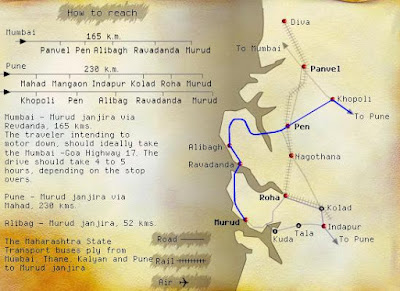Murud-Janjira is the local name for a fort situated at the coastal
The word Janjira is not native to
At the time they seized the fort, the Siddis were employed by the Bahamani Sultan of Ahmednagar and a Habshi, Malik Ambar (1550-1626), held a prominent position in that government. Before the rise of the Maratha sardars, the courts of the Bahamani sultanates were rent by rivalry between the Indian Muslims and the foreign Muslims, as a result of which, the Sultans began to patronize the Marathas as a third force, leading to the rise of Shivaji and the Maratha Empire.

Malik Amber initially rose to great prominence as the Prime Minister of Ahmednagar. He is credited with having carried out a systematic revenue settlement of major portions of the
When the Ahmadnagar kingdom was conquered by Bijapur and the Mughals in alliance, the Siddis switched their allegiance to the Sultanate of Bijapur; when the Bijapur kingdom was conquered by the Mughal Empire, the Habshis switched their allegiance to the Mughal Empire.As clients of these Muslim states, the Siddis were nominally part of their navies, and fulfilled the role of defending Muslim interests in the sea, and particularly, access by sea for the Hajj and Umrah, for which reason, the interior Muslim states felt compelled to aid and rescue the Siddis from their enemies.
Despite being feudatories, first of Bijapur and then of the Mughals, the Siddis acted as if they were independent, and lived mainly by piracy on coastal shipping.
The piracy of the Siddis provoked the various local powers to attempt to suppress them, but despite eforts by the Portuguese, Dutch, English and the Marathas, the fort was never conquered. The fort thus earned a reputation for being impregnable.

The reputation may be false. Mass mobilizations by the English and Marathas were always forced off before they could complete the task by the intervention of another power, such as the Mughals, creating a diversion in order to prevent the fall of Murud-Janjira. It must be noted that the same happened with Goa, with the Mughals invading Maratha lands in order to divert Maratha attempts to conquer
The name of the fort is a concatenation of the Konkani and Arabic words for
The State of Murud-Janjira was known to the Maratha Empire as Habsan, the and of the Habshis.The founder of what later developed into the Maratha Empire, Shivaji Bhosale, sent his Prime Minister or Peshwa, Moropant Pingle to conquer the Siddis and end their piracy during August, 1676, albeit unsuccessfully. Shivaji's inability to capture this fort led him to build the Vijaydurg fort down the coast, and also a fort named Sindhudurg on the
The English too strived in vain to suppress the Siddis, and the Siddis even succeeded in seizing

As the Muslim powers of the interior waned in the face of rising English power, the Siddi state submitted to
HOW TO REACH THERE



(2) Kalal Bangdi, Landakasam and Bhavani, the cherished weapons of the Sidis, built from five metals

(3)Beaches: which are filled with the serenity
(4) Carambi Dharan (Dam), a picnic spot providing clean water through pipes to Murud throughout the year channeled from its natural springs.
(5)Datta Mandir (temple) atop a hill, a picturesque spot giving an extraordinary view of the sea.
(6)Sidhi Vinayak Temple of the Hindu deity Lord Ganapati.
SOME
(7)Alkapuri, a picnic spot favored for its lush green vegetation.
SOME MORE SNAPs :
Fisherfolk at Murud Beach

Sand Castle at Murud Beach
Dumeril's black-headed snake Sibynophis subpunctatu...

Mosques inside Janjira (Jazeera) fort

caves at Murud

MORE

<>






















